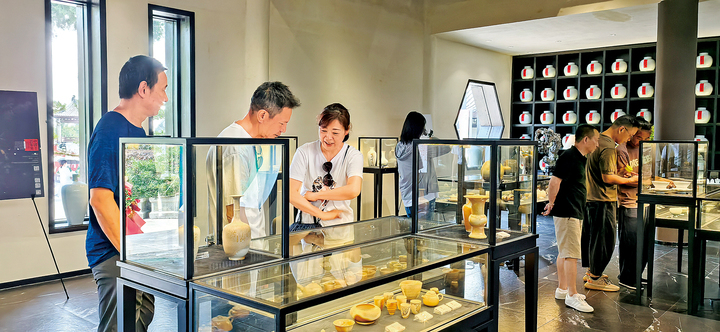Women’s March 2019: The leaders of the march are not the women’s movement.
Recently in Politics
- Let’s Catch Up on How Trump’s Vice Presidential Candidates Are Humiliating Themselves
- The House Republicans’ Teen Soap Opera Is Reaching New Lows
- Evidence Is Building That Samuel Alito’s Brain Is Filled to the Brim With Right-Wing Internet Chum
- Many Young Voters Have Turned on Biden. But a Different Group Just Might Rescue Him.
When I attended the Women’s March convention in October 2017, I expected to witness little more than a three-day pep rally. Women with the financial capacity to take time off work, travel to Detroit, and abide the business-casual dress code would spend a weekend listening to rousing speeches and celebrity-stocked panels. They’d leave having made a few friends, their post-march euphoria reinstated, and go back to their lives feeling accomplished for having cheered and chanted a second time that year.
My cynical predictions about the limited longevity and political efficacy of a dispersed and unfocused movement were deeply ill-founded. In Detroit, I found women from all over the country who’d fundraised to make the trip, some of whom were the sole representatives of their hometown activist circles. While they listened as national leaders talked about the threats the Trump administration posed to American democracy, they weren’t just passive receptacles for information. On panels and in sidebar conversations, they shared strategies that had helped them make an impact on state and local issues. Dozens were trained to run for political office. Hardly anyone followed the dress code.
For a lot of these women, the 2017 Women’s March had marked their first act of public protest, a galvanizing exhale and outlet for the anger that had built up around the 2016 election. But it was also a call to sustained action that both existing advocacy organizations and ad hoc Trump-inspired activist groups were happy to take up. With its broad, progressive platform, the Women’s March left room for participants to lean into the issues that mattered most to them without limiting the scope of their politics in exclusionary ways. The march itself was a one-day expression of unity, but the avenues of activism it led women to seek out were specific, idiosyncratic, and sustainable.
AdvertisementAt the same time, there seemed to be a major disconnect between the way participants and activists approached the Women’s March organization (seeing it as a venue for sharing and supporting other activism they were doing) and the way the organization treated its leaders (viewing them as extraordinary shepherds of a single movement). Tamika Mallory, Carmen Perez, Bob Bland, and Linda Sarsour moved through the convention like celebrities, just as visible yet untouchable as some of the A-list actresses on the speaker’s docket.
Advertisement Advertisement AdvertisementThey took the stage at nearly every keynote event and were surrounded at all times by a buffer of suit-clad security guards. (This isn’t a dig—I’m sure they’ve received plenty of violent threats, and Sarsour in particular has been the target of extreme hate speech—but it did promote an image of exclusivity and stardom.) At a general-admission standing-room concert that followed convention programming one night, the four leaders arrived late and sidled in right in front of the stage, displacing the women who’d gotten there early to claim good spots. The row of enormous bodyguards who’d preceded the latecomers, asking the crowd to step back and make room, blocked the original occupants’ views.
AdvertisementI’ve thought about this disconnect between what the Women’s March means to participants and what it means to its leaders many times over the past several weeks, as debates about Mallory’s admiration for Louis Farrakhan—the notoriously anti-Semitic, homophobic, and sexist Nation of Islam leader—have played out alongside the decisions of several major organizations, including the DNC, the NAACP, EMILY’s List, the National Council of Jewish Women, and the Southern Poverty Law Center, to cut ties. Critics accuse the organization of marshaling insufficient opposition to anti-Semitism—in addition to Mallory’s refusal to “condemn” Farrakhan or his rhetoric on The View(“I don’t agree with many of Minister Farrakhan’s statements,” she said), there was a Tablet story in December that contained allegations, denied by the Women’s March organization, that Mallory and Perez made anti-Semitic remarks at an initial leadership meeting in late 2016.
Advertisement AdvertisementIn response to these critiques, the Women’s March announced a new steering committee and organized a special marching contingent for Jewish women for the annual event this Saturday. Three Jewish members of the committee—two women of color and one woman of trans experience—published a Medium post on Wednesday explaining why they’re still marching: “The magic of the Women’s March movement,” they write, “is that it brings so many incredible women from all backgrounds into a room to fight for a shared vision of the world we want to live in.”
AdvertisementIn a room bulging with representatives from so many dissimilar communities and lived experiences, bitter conflict is inevitable. So is some degree of resentment. Some white feminists famously complained—and many decided to forgo the march altogether—when it became clear the 2017 march wasn’t going to paper over the fact that a majority of white female voters had cast their ballots for Trump. Feminists of color had good reason to be suspicious of a sudden wave of white women ready to protest just because a proud misogynist and alleged abuser had been elected president, when so many had remained silent for so long in the face of any injustice that didn’t directly affect their own lives.
Advertisement Advertisement Advertisement The Women’s March had provided a vehicle for self-organizing in activist circles, but it wasn’t steering their progress.But the uncomfortable conversations, ugly truths, and personal offenses that bubble up when people try to understand one another across race and class to work together for social change should not reflect poorly on the effort as a whole. That discomfort and anger is a necessary byproduct of organizing diverse movements. You might even say it’s an indicator that something is going right.
The history of feminism is woven through with racism, homophobia, transphobia, and every other form of bias that infects the society that feminist movements have attempted to transform. A march concerned with seamless agreement might have tried to ignore those biases and histories of women-perpetrated oppression, thereby excluding the experiences of women who suffer most under the patriarchy (and Trump). Such a march would have been much smaller, rapidly discredited, and a massive lost opportunity to plot a course for an inclusive, self-correcting mainstream feminism.
AdvertisementInstead, the Women’s March leaned into the differences and difficulties, in hopes of bringing into the open the hard conversations some feminists have long avoided. As Rebecca Traister wrote this week, “The painful reflections and calls to responsibility were meant to bring anger to the surface as part of the process of marching together, rather than allowing that anger to fester and separate a group that could, united, wield power.” What many outsiders have heard as evidence of a fractured, infighting movement were, in fact, the sounds of communities confronting fissures that already exist.
Advertisement AdvertisementEven so, the organization’s decision to elevate four particular women—at least one of whom is loath to disavow men who are garbage—as the faces of the movement was a bad one. The future of feminism is decentralized and non-hierarchical, with none of the march’s aggressive, ubiquitous branding. It cannot and will not rest on personality and aesthetics; neither should it be subject to the whims of ego or personal soft spots for people with bad politics.
AdvertisementIn addition to Mallory’s unwillingness to give up ties to a sexist anti-Semite, the organization has proved hostile to well-founded criticism. A Women’s March PR representative emailed me and many other journalists who tweeted the Tablet story in December and asked us to delete those tweets—an audacious request the likes of which I’d never previously encountered in my career. Bland once sneered at me when I met her at the convention and told her I worked for Slate, saying, “They could really use some better journalists over there, couldn’t they?” (I was too taken aback to quibble with her, but I assume she was referring to the one semi-critical piece Slate had published about the march: my reporting on the group’s failure to get a permit to protest at the Lincoln Memorial even as it continued to falsely promise a rally would be held at that location.) The leaders of the Women’s March have conducted themselves as if the gargantuan, multifaceted uprising of women across the country reflects on them personally—and vice versa—and the national news media has taken its cues from them.
Advertisement Advertisement AdvertisementThe women who’ve mobilized to join the movement have been under no such illusions. At the 2017 Women’s March, only a small fraction of attendees ever made it close enough to see or hear the programming on the stage. Several months later, at the convention, no one was talking about what the four leaders said in their addresses (with the possible exception of the extraordinarily charismatic Sarsour) or asking what the march’s platform said. They were talking about how to get more women into their state legislatures, when to hold a sit-in outside their congressman’s local office, which voters to target in registration drives, how white activists could best support black students who wanted to stage a protest during the national anthem at a high school football game. The Women’s March had provided a vehicle for self-organizing in activist circles and consciousness-raising groups, but it wasn’t steering their progress.
Advertisement AdvertisementIf another Women’s Convention were held today, I suspect the tenor would be different. Some Jewish women might elect to stay home, as some are doing during this year’s march; there would certainly be more talk of the leaders’ baffling decision to argue semantics and mince words about Farrakhan instead of letting him go and moving on. But I’m not convinced that the fate of the Women’s March organization, which has also allegedly been mismanaged on the financial and organizational sides, will have too much of an effect on the activism it’s sparked.
AdvertisementThe energy and hunger the Women’s March helped shape has already born fruit, and if the enthusiasm around all the new women recently elected to Congress—the most diverse and pro-choice Congress the country has ever seen—is any indication, the momentum powering this widespread women-led agitation for social change will not soon abate. The Women’s March gave existing advocacy groups a renewed sense of urgency and thousands of new members. But the groundswell of political activism that followed is better understood as a lowercase women’s march: an unaffiliated, unpermitted movement toward progress too massive to be thrown off-course by any one member, even if she’s standing at the front.
Tweet Share Share Comment相关文章

Slot extends perfect Liverpool start
LONDON:Arne Slot extended his perfect start as Liverpool manager with a 2-0 win against Brentford on2024-09-21 雅安日报讯市区雅州大道即将竣工,昨(17)日,市城市管理行政执法局联合市公安、市工商、雨城区等相关部门针对沿途摆摊设点、占道经营等不规范现象进行专项治理。“大爷您好,雅州大道是雅安的形象窗口,沿途是不2024-09-21
雅安日报讯市区雅州大道即将竣工,昨(17)日,市城市管理行政执法局联合市公安、市工商、雨城区等相关部门针对沿途摆摊设点、占道经营等不规范现象进行专项治理。“大爷您好,雅州大道是雅安的形象窗口,沿途是不2024-09-21 雅安日报讯22日,“关助工程”之雅安震后伤员康复支持项目启动仪式在市人民医院举行。该项目将帮助此次“4·20”芦山强烈地震中致残的伤员,维持和提高他们的肢体活动功能,并通过一年时间,通过社区家访、小组2024-09-21
雅安日报讯22日,“关助工程”之雅安震后伤员康复支持项目启动仪式在市人民医院举行。该项目将帮助此次“4·20”芦山强烈地震中致残的伤员,维持和提高他们的肢体活动功能,并通过一年时间,通过社区家访、小组2024-09-21 2024-09-21
2024-09-21 现场观众驻足欣赏精美的蒙山窑瓷器用名山土,烧蒙山器,泡蒙山茶。8月24日,蒙山窑艺术馆开馆仪式在蒙顶山4A级旅游景区举行,一大批采用蒙顶山优质高岭土烧制的蒙山窑瓷器惊艳亮相,吸引了不少瓷器爱好者及游客2024-09-21
现场观众驻足欣赏精美的蒙山窑瓷器用名山土,烧蒙山器,泡蒙山茶。8月24日,蒙山窑艺术馆开馆仪式在蒙顶山4A级旅游景区举行,一大批采用蒙顶山优质高岭土烧制的蒙山窑瓷器惊艳亮相,吸引了不少瓷器爱好者及游客2024-09-21 戳这里→教你正确品鉴、泡饮道地新会陈皮!_南方+_南方plus阳春三月到来,万物复苏,柑花盛开满园。是时候品味一杯温暖的新会陈皮茶,漫步柑园欣赏满园春色。作为中国传统药材和调味佳品,新会陈皮凭借其独特2024-09-21
戳这里→教你正确品鉴、泡饮道地新会陈皮!_南方+_南方plus阳春三月到来,万物复苏,柑花盛开满园。是时候品味一杯温暖的新会陈皮茶,漫步柑园欣赏满园春色。作为中国传统药材和调味佳品,新会陈皮凭借其独特2024-09-21

最新评论